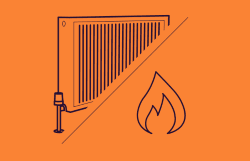The energy market as a whole
Whenever the energy market is discussed on the national news, more often than not it is heavily focussed on the ‘residential’ side of thing. There is such a heavy emphasis on changing energy prices for the home, that you would be forgiven for thinking that there is only a single energy market for every consumer.
But there isn’t. There actually appears to be several distinct sections of the market that although they are interlinked, respond to market forces in completely different fashion from one another.
The energy market can be broadly categorised into three sections; Residential, SME, and Corporate / business energy. Each section will show differing volatility in response to market forces (which are passed on to consumers), and in this article we will begin to tackle theory behind why.
The residential energy market: The residential energy market will be for the majority of people, the most familiar. It is the market in which the energy for your home is purchased from suppliers. Prices in this market move in a broadly uniform fashion, changing around twice a year by energy suppliers.
SME: The SME market is where business energy suppliers will pre-purchase energy in advance – guaranteeing a fixed price for a fixed period for a set number of customers. This market is more exposed than the residential market, but protected slightly from wholesale market movements by ‘tariff sheet pricing’.
Corporate: Due to the large size of these customers and their sky-high energy needs in combination to protectionist policies of energy suppliers – this market shows incredible price volatility.
What is price volatility?
It is a term that should be known for any type of industry – not just the energy sector. It is used to describe price fluctuations of a certain product or service, over a given period of time. This can be monthly, daily, or even half-hourly (as you will find out later on).
In a free market economy, or mostly free, you will find that the price of a good is dictated by both supply and demand. Or more importantly – their relative position to one another.
It is difficult to grasp this idea without a real-world example. The most memorable examples also happen to be the most bizarre.
Picture a fresh-fish market in any town or city you please. For the most part, all of the fish on offer will be caught locally by local fisherman. They either sell their fish directly to shopkeepers, or will display their catches on the market floor and wait for a customer to approach. Once a customer would like to purchase a fish, they will enter into negotiations to find a fair price for the product. Both customer and supplier leave feeling satisfied with the transaction.
But what happens if the following week a severe storm hits? Many of the fisherman will choose to not go to sea as it is too dangerous, while a few braver souls will still venture out. Due to less boats in the water, at the market there will be much less fish for the same number of customers. Supply has fallenwhile demand has remained the same.
As a result, the prices negotiated for the exact same type of fish will be considerably higher. Suppliers will demand higher prices due to the higher costs they have incurred in terms of risk and extra fuel costs from battling against the storm. It is also easier to ask for a higher price for the product if there 6 customers all wanting to purchase the same fish, and it is known they have limited options.
As a result of market forces – the price for the same product has risen over the course of a week. This is price volatility.
Price volatility and the energy market
Now the theory of what price volatility has been established, and the three sub-sections to the energy market has been described – we can now move on to how they intertwine with one another.
Energy suppliers will purchase their energy from producers in huge quantities in order to then sell it onwards to customers. The prices that customers will have to pay are influenced hugely by the costs that suppliers have to incur.
| Factor | Description |
| Extreme weather conditions | Extreme weather conditions can effect supply infrastructure, limiting supply and increasing costs. Hot or cold weather will increase energy demand, also driving up costs. |
| Economic Conditions | Rapidly growing economies will exert pressure to provide more infrastructure, which will drive up costs. Poorly performing economies will often act conversely. |
| Availability of Supply | If a fossil fuel source has been exhausted in a certain area, or a new source has begun to be exploited – supply will rise or fall and prices will change accordingly. |
Although residential customers do face price changes – and though these changes impact many people throughout the UK, they are absolutely dwarfed by the other two markets in terms of price volatility.
Why are the Corporate and SME markets more volatile?
This is for the most part, due to scale. As business customers will need so much more energy – there is real risk for suppliers to lose huge sums of money if their pricing strategy is not up to date. The SME market works by suppliers pre purchasing energy and therefore will be able to guarantee a set price for a fixed period, for a certain volume of customers. However, once this allocation has been used – it is gone. Any business who then comes late will be exposed to a much higher price in relation to the rest of the market.
The SME market is affected by the live whole-sale market too. As the wholesale market fluctuates – suppliers will withdraw their tariff sheets to re-price them according to new market positions before re-releasing the revised prices to the market (also following procurement of energy). On average the SME market will have around thirty price changes per month.
For corporate customers – thirty price changes a month is child’s play. Due to the incredible volume of energy needed, suppliers need to protect themselves against any variability in customer behaviour. If they didn’t protect themselves – they would be left struggling to match supply and demand of energy, and would lose vast sums of money purchasing more expensive energy from the short-term market.
Due to this – there is a unique pricing market for corporate customers that is directly based off of the wholesale market level. The wholesale market for energy pricing is updated every thirty minutes, and as it is used to calculate bespoke corporate energy prices – corporate customers are vulnerable to price volatility over thirty-minute intervals.
How is volatility calculated?
It is incredibly difficult to quantify volatility – as if data is not normalised then it is possible to reach incredibly misleading conclusions. Volatility is a key input for many financial and risk management decisions for any energy trader. By calculating volatility, and graphing the results – it allows for a unique insight into the industry. It is possible to read more about this here.
Energy Volatility Index – EVI – POWER and GAS
Is price volatility good or bad?
Price volatility is neither inherently good nor bad. As price volatility works both ways – you are just as capable of procuring an incredibly priced deal relative to the rest of the market as you are being left to pay way over the odds.
In the residential market – due to the lack of volatility in prices, there is less opportunity to capitalise on low priced energy. As suppliers in the residential market seem to move prices together in the same direction, it is unlikely you will find a gem of a deal compared to any other customer.
In comparison the wholesale market is known for being incredibly volatile, and as it has a direct effect on SME and Corporate markets – so too are they. This allows for forward-thinking individuals with a good grasp of the market to strike at opportune moments, and secure a great energy contract.
The opposite still holds true here too. If you are not prepared for changes in the market, or are taken off guard by an upswing – then you very well could be stuck paying vast sums for your energy.
Common Questions
Is price volatility bad?
No! Price volatility works both ways, and the volatility allows for incredible savings to be made if you know how to play your cards right.
Why does my energy prices keep changing?
This depends – the nature of your energy contract is important to know. It is important to remember that there are hundreds of factors that could contribute to affecting your suppliers’ costs in providing your energy, and they may need to change their pricing accordingly.
What causes price volatility in the energy market?
There is no limit to exogenous factors that could cause volatility in the energy market. The most commonly occurring categories are; Extreme weather conditions, economic conditions, and availability of supply.




